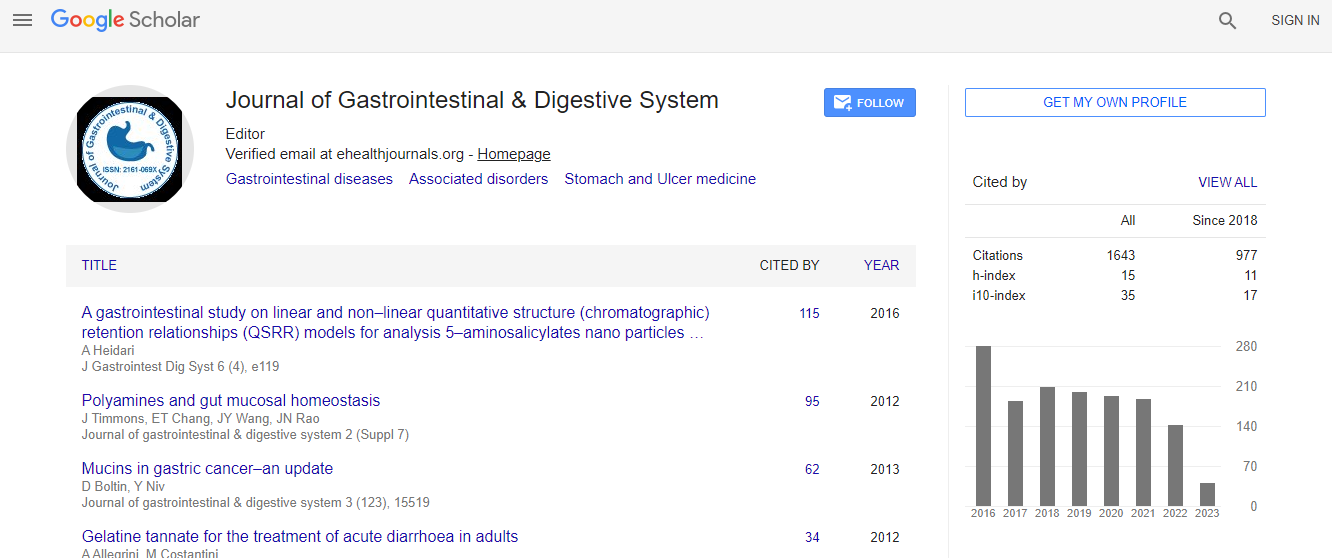Our Group organises 3000+ Global Conferenceseries Events every year across USA, Europe & Asia with support from 1000 more scientific Societies and Publishes 700+ Open Access Journals which contains over 50000 eminent personalities, reputed scientists as editorial board members.
Open Access Journals gaining more Readers and Citations
700 Journals and 15,000,000 Readers Each Journal is getting 25,000+ Readers
Google Scholar citation report
Citations : 2091
Journal of Gastrointestinal & Digestive System received 2091 citations as per Google Scholar report
Journal of Gastrointestinal & Digestive System peer review process verified at publons
Indexed In
- Index Copernicus
- Google Scholar
- Sherpa Romeo
- Open J Gate
- Genamics JournalSeek
- China National Knowledge Infrastructure (CNKI)
- Electronic Journals Library
- RefSeek
- Hamdard University
- EBSCO A-Z
- OCLC- WorldCat
- SWB online catalog
- Virtual Library of Biology (vifabio)
- Publons
- Geneva Foundation for Medical Education and Research
- Euro Pub
- ICMJE
Useful Links
Recommended Journals
Related Subjects
Share This Page
Oesophageal perforation - A life threatening complication of balloon tamponade with a sengstakenblakemore tube for bleeding oesophageal and gastric varices
International Conference on Digestive Diseases
Brianna Twomey
St Vincent's Hospital, Australia
ScientificTracks Abstracts: J Gastrointest Dig Syst
Abstract
Introduction: Balloon tamponade using a Sengstaken- Blakemore (SB) tube is an effective lifesaving option in the management of acute oesophageal and gastric variceal bleeding. The procedure is often used as a temporising measuring to achieve short term haemostasis by applying direct compression to varices until more definitive treatment can be instituted. However, the use of a Sengstaken-Blakemore tube has been associated with a number of complications including aspiration pneumonia, airway obstruction, and oesophageal erosion and perforation. Case Report/Method: We present a case of a patient who developed an oesophageal perforation following the insertion of a Sengstaken-Blakemore tube and performed a literature review of similar cases. Results: A 53 year-old male presented with haematemesis and melena on the background of Child-Pugh B cirrhosis secondary to hepatitis C virus. The patient was commenced on Octreotide and Pantoprazole infusions, and endoscopic band ligation of oesophageal varices was later performed. Following the procedure, the patient suffered ongoing haematemesis and was transferred to the intensive care unit for resuscitation and urgent intervention. Rapid endotracheal intubation was followed by a gastroscopy that revealed fresh blood in the stomach. A Sengstaken-Blakemore tube was inserted and the gastric balloon inflated following confirmation of tube position with auscultation. A subsequent chest radiograph revealed a round radiolucent area corresponding to the gastric balloon projecting over the right hemi-thorax. The gastric balloon was immediately deflated and removed. A full thickness oesophageal tear was further confirmed by a repeat gastroscopy and computed tomography imaging. Conclusions: Oesophageal perforation secondary to Sengstaken-Blakemore tube misplacement is a relatively rare complication, however it carries a high incidence of associated mortality. This case supports the literature and illustrates that auscultation alone is not an adequate method to confirm Sengstaken-Blakemore tube placement. We recommend the use of routine chest radiography or ultrasonography before and after balloon inflation. Endoscopic guided insertion is another method that can be utilised to ensure correct balloon positioning.Biography
Brianna Twomey is currently working in St. Vincent's Hospital, Melbourne, Australia.
Email: briannatwomey@hotmail.com

 Spanish
Spanish  Chinese
Chinese  Russian
Russian  German
German  French
French  Japanese
Japanese  Portuguese
Portuguese  Hindi
Hindi 
